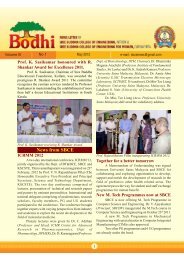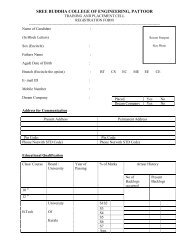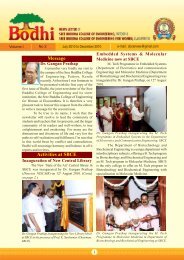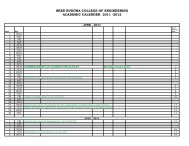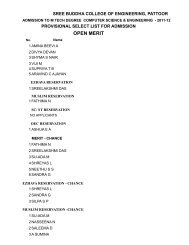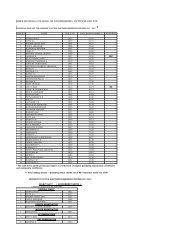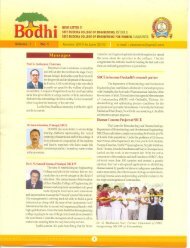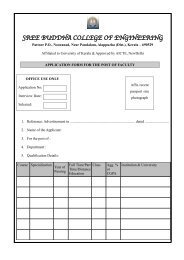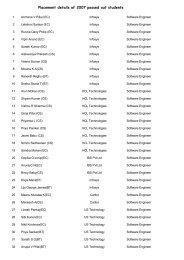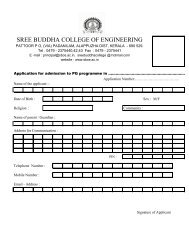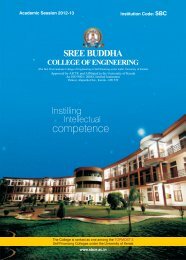UNIVERSITY OF KERALA
UNIVERSITY OF KERALA
UNIVERSITY OF KERALA
Create successful ePaper yourself
Turn your PDF publications into a flip-book with our unique Google optimized e-Paper software.
MODULE I<br />
INTRODUCTION: Importance of heat transfer in bioprocessing industries, various applications and principle and<br />
mechanism of the different modes of heat transfer Viz. Conduction, Convection and Radiation.<br />
CONDUCTION: General heat conduction equation in rectangular geometry, Laplace equation, Poisson equation, heat<br />
diffusion equation, different boundary conditions applied in heat transfer problems, formulation of heat transfer<br />
problems using different boundary conditions with and without generation of heat at steady state and unsteady state for<br />
rectangular, cylindrical and spherical geometries at steady and unsteady states. Fourier’s law, thermal conductivity of<br />
materials, Steady state unidirectional heat flow through single and multiple layer slabs, cylinders and spheres with<br />
constant and variable thermal conductivities. Numerical problems.<br />
Solution of steady state one dimensional heat conduction with heat generation in slabs, cylinders, spheres. Numerical<br />
problems.<br />
Unsteady state conduction: Elementary treatment of unsteady state heat conduction- Lumped capacity analysis. Biot<br />
Modulus, Fourier number and their significance. Numerical problems. Chilling and freezing of food and biological<br />
materials. Unsteady state thermal processing and sterilization of biological materials. General principles of thermal/heat<br />
sterilization, sterilization of medium using High Temperature Short Time (HTST) methods. Design of Continuous<br />
sterilizers.<br />
INSULATION: Properties of insulation materials, Types of insulation, Critical radius and Optimum thickness of<br />
insulation.<br />
EXTENDED SURFACES: Fins – Types of fins, general conduction analysis of fins for different boundary conditions.<br />
Solution of general conduction equation for temperature profile and rate of heat transfer at different boundary<br />
conditions (Constant temperature, infinitely long fin, insulated tip boundary conditions), fin efficiency and fin<br />
effectiveness. Numerical problems.<br />
MODULE II<br />
CONVECTION: Boundary layer concept, thermal and velocity boundary layer and the relationship between the two.<br />
Film concept of heat transfer, Individual and overall heat transfer coefficient, LMTD, LMTD correction factor.<br />
Dimensional numbers - Dimensional analysis, Buckingham’s pi theorem, Empirical correlation for forced and natural<br />
convection for internal and external flows (flows over flat plates, cylinders and spheres)- Numerical problems. A brief<br />
introduction of the analogy between momentum and heat transfer – Reynolds, Colburn and Prandtl analogies, their<br />
merits and demerits (Deriving the analogy expressions from the basic concepts is not desired. Only analogy expressions<br />
and their significance are required).<br />
RADIATION: Properties and definitions, Absorptivity, Reflectivity, Emissive power and intensity of radiation, Black<br />
body radiation, Gray body radiation, Stefan – Boltzman law, Wien’s displacement law, Kirchoffs law, View factors,<br />
Radiation between surfaces:- two black bodies, two infinite parallel grey planes, one small grey body enclosed in<br />
another black body. A brief overview of radiation involving gases and vapours.<br />
MODULE III<br />
HEAT TRANSFER WITH PHASE CHANGE: Boiling heat transfer: Types of boiling, factors affecting boiling heat<br />
transfer coefficient, dimensionless variables, Pool boiling curve, Correlations for determining boiling heat transfer<br />
coefficient- Rohsenow correlation, Critical heat flux- Zuber correlation and minimum heat flux- numerical problems.<br />
Elementary treatment of flow boiling with its different regimes. Numerical problems.<br />
Condensation – Types of condensation, Nusselt’s equation (Derivation is required), correlations for determination of<br />
condensing coefficients for film condensation on single cylinders (horizontal and vertical orientations), spheres and<br />
banks of tubes- Numerical problems<br />
HEAT TRANSFER EQUIPMENT: Detailed classification of heat exchangers based on different modes, Types of<br />
shell and tube heat exchangers, their constructional details indicating the function of various components. Condenser –<br />
types of condensers, Use of Wilson’s plot, Elementary design as to the determination of area, length and number of<br />
tubes for shell and tube heat exchanger and condensers.-Numerical problems. A brief overview of Effectiveness-NTU<br />
method of analysis of heat exchangers (Derivation of expressions for effectiveness is not required). Use of<br />
effectiveness-NTU plots- Numerical problems<br />
Use of plate-heat exchangers for biological fluids. Construction and basic design of plate heat exchangers with the<br />
correlations used for the design.<br />
EVAPORATORS: Types of evaporators, performance of tubular evaporator – Evaporator capacity, Evaporator<br />
economy, Material and energy balance in single effect evaporators. Multiple effect evaporators – Methods of feeding,<br />
Effect of liquid head and boiling point elevation. Factors to be considered in the selection of evaporators, Calculations<br />
38



